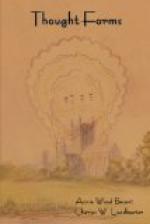There are some serious difficulties in our way, for our conception of space is limited to three dimensions, and when we attempt to make a drawing we practically limit ourselves to two. In reality the presentation even of ordinary three-dimensional objects is seriously defective, for scarcely a line or angle in our drawing is accurately shown. If a road crosses the picture, the part in the foreground must be represented as enormously wider than that in the background, although in reality the width is unchanged. If a house is to be drawn, the right angles at its corners must be shown as acute or obtuse as the case may be, but hardly ever as they actually are. In fact, we draw everything not as it is but as it appears, and the effort of the artist is by a skilful arrangement of lines upon a flat surface to convey to the eye an impression which shall recall that made by a three-dimensional object.
It is possible to do this only because similar objects are already familiar to those who look at the picture and accept the suggestion which it conveys. A person who had never seen a tree could form but little idea of one from even the most skilful painting. If to this difficulty we add the other and far more serious one of a limitation of consciousness, and suppose ourselves to be showing the picture to a being who knew only two dimensions, we see how utterly impossible it would be to convey to him any adequate impression of such a landscape as we see. Precisely this difficulty in its most aggravated form stands in our way, when we try to make a drawing of even a very simple thought-form. The vast majority of those who look at the picture are absolutely limited to the consciousness of three dimensions, and furthermore, have not the slightest conception of that inner world to which thought-forms belong, with all its splendid light and colour. All that we can do at the best is to represent a section of the thought-form; and those whose faculties enable them to see the original cannot but be disappointed with any reproduction of it. Still, those who are at present unable to see anything will gain at least a partial comprehension, and however inadequate it may be it is at least better than nothing.
All students know that what is called the aura of man is the outer part of the cloud-like substance of his higher bodies, interpenetrating each other, and extending beyond the confines of his physical body, the smallest of all. They know also that two of these bodies, the mental and desire bodies, are those chiefly concerned with the appearance of what are called thought-forms. But in order that the matter may be made clear for all, and not only for students already acquainted with theosophical teachings, a recapitulation of the main facts will not be out of place.




